AB1876
New Member
Hello everyone, First time poster here.
I have an interest in a Victorian era branch line called the Alcester Branch. You can read more about this line here https://en.wikipedia.org/wiki/Alcester–Bearley_branch_line but in short, it joined the competing Midland Railway and GWR lines on a single track line opening in 1876. The branch line was barely profitable and suffered from the emergence of the motor vehicle, making it easier to move goods and freight. The line closed during both world wars with the operators probably being thankful due to the lack of profit being made on it - the closure was just an inevitability. It opened again during the war to transport Coventry workers from their relocated factory in Great Alne. It was used to store crippled wagons until its full closure in 1951. I believe the land was sold off by the British Transport Commission in around 1961. The track therefore was taken up between 1951 and 1961.Sections of the line are walkable today and I have recently been taking walks on it on the odd weekend. I have come across some items along the line but I'm just not educated enough on this subject to make an identification. I would be grateful for any help on the below objects.
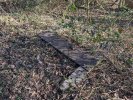
Out of all the items this looks most likely to have been part of a railway track
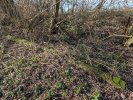
Some kind of concrete post - possibly to carry cables?
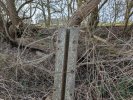
This object stuck out. It had been put in the ground for some reason. Repurposed from the railway or just an old fence post from the farm?
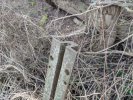

Like the previous object it had been put in the ground and really stuck out. It certainly looks like a piece of rail track. It would be great to get this ID'd.
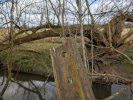
I have an interest in a Victorian era branch line called the Alcester Branch. You can read more about this line here https://en.wikipedia.org/wiki/Alcester–Bearley_branch_line but in short, it joined the competing Midland Railway and GWR lines on a single track line opening in 1876. The branch line was barely profitable and suffered from the emergence of the motor vehicle, making it easier to move goods and freight. The line closed during both world wars with the operators probably being thankful due to the lack of profit being made on it - the closure was just an inevitability. It opened again during the war to transport Coventry workers from their relocated factory in Great Alne. It was used to store crippled wagons until its full closure in 1951. I believe the land was sold off by the British Transport Commission in around 1961. The track therefore was taken up between 1951 and 1961.Sections of the line are walkable today and I have recently been taking walks on it on the odd weekend. I have come across some items along the line but I'm just not educated enough on this subject to make an identification. I would be grateful for any help on the below objects.

Out of all the items this looks most likely to have been part of a railway track

Some kind of concrete post - possibly to carry cables?

This object stuck out. It had been put in the ground for some reason. Repurposed from the railway or just an old fence post from the farm?


Like the previous object it had been put in the ground and really stuck out. It certainly looks like a piece of rail track. It would be great to get this ID'd.



